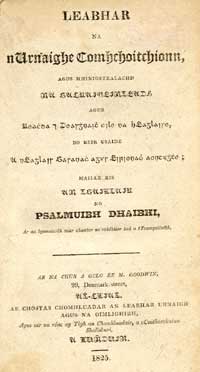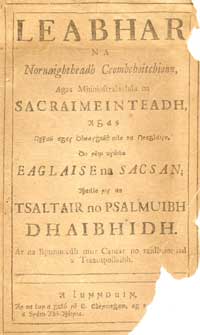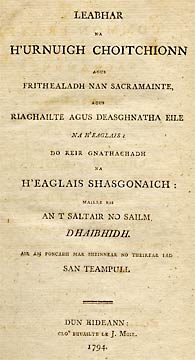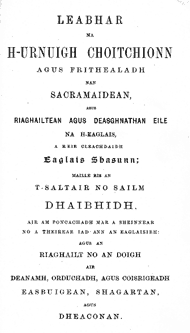CHAPTER IX
THE IRISH TRANSLATION OF ARCHBISHOP DANIELL, AND ITS SUCCESSORS
THE Irish language is one of the dialects
of the Gaelic branch of the Celtic family of languages, the Scottish-Gaelic
and the Manx being the other dialects of the same branch. It is generally
stated that the first printing press was that of Humphrey Powell, in
Dublin, 1550, and that the first book printed there of which we have
authentic record, i.e. name of printer, place and date, is the “Boke
of Common Prayer,” etc.,
by Powell, in 1551. The correctness of this assumption is very much doubted
by C. Winston Dugan in his introduction, page 8, to Books
printed in Dublin in the 17th Century. List compiled by Ernest Reginald
McClintock Dix, Dublin, 1898 foll.
A few years after Queen Elizabeth had ascended the throne, she provided John O’Kearnagh, at her own expense, with a fount of Irish type,-a curious mixture of roman, italic and Irish letters. The first book printed in Irish was the Aibidil . . . air Caiticiosma or, Alphabetum et ratio legendi Hibernicum et Catechismus, by John O’Kearnagh; first edition 1563, of which no copies are known now to exist; second edition 1571. The second book seems to have been the New Testament translated by Archbishop Daniell and others, 1602 (1603). The fourth book printed from the Queen’s fount was the Irish translation of the Book of Common Prayer, 1608.
The religious instruction in Ireland was somewhat neglected at the time
of the Reformation. It was agreed that the worship should be in a tongue
understood by the people. Yet the Liturgy in Irish was not given to the
people for nearly sixty years, Haddon’s Latin translation serving
in the meantime as a substitute.
Griffiths 64:1
The title of the editio princeps of the Irish translation reads: Leabhar na Nvrnaightheadh gComhchoidchiond agus Mheinisdraltachta na Sacrameinteadh, maille le Gnathaighchibh agus le Hordaighthibhoile, do réir eagailse na Sagsan.
A dtigh Shéon Francke, alias Franckton[1], a Mbaile athá Cliath [Dublin], 1608.
Without pagination. Folio. Paper, 7½ x 9⅞ inches. Title in an elaborate architectural compartment with four masks. Title and preliminaries occupy 15 leaves, conntaining on the reverse of the title-page the arms of King James. Then follows the dedication to Sir Arthure Chichester, in English, signed Will. Tuamensis (2 leaves). Next comes the Act of Uniformity, etc., in the Irish character; Almanack, and Table of feasts, 1609-1641. Text on sig. a — V, Aa — Vu, AAa — Uuu, in twos. The last leaf contains a large wood-cut of the coat of arms of Chichester.
The first edition does not contain the Psalter. It was translated by the Most Revd. William Daniell, archbishop of Tuam, the same prelate who in 1603 had brought out the first Irish version of the New Testament[2]. The text of the Liturgy translated was that of the Hampton Court Book. It was dedicated to the Lord Deputy, Sir Arthur Chichester. The archbishop had probably the same help as in the case of the translation of the New Testament, viz., the work left by Nicholas Walsh and Nehemias Donnellan. The bishop also went through Connaught looking for further aid, and secured the services of Mortogh O’Kionga (King; also written Muircheartach O’Cionga), a well-known Irish scholar, who had become a Protestant, obtained a church living, and, on the recommendation of Archbishop Ussher was employed by Bishop William Bedell (1571-1642) on his Irish translation of the Scriptures.
Of the chief persons interested in this first Irish version of the Liturgy suffice it to say that:
John O’Kearnagh (O’Kearney, Kearney, Carney) in Irish Sean O Cearnuidh, an Irish Protestant divine, studied at . Cambridge University and returned to Ireland in 1563 after a long stay at that seat of learning. He aided the bishops to disseminate Protestant doctrines among the Irish people through the medium of their native language. In 1571 he was made treasurer of St. Patrick’s, Dublin, by Archbishop Adam Loftus (1533 ?-1605), of Armagh and Dublin. This position he held till 1582. He translated the Psalms into Irish. He died about 1600.
William Daniell (O’Donnell, O’Domhnuill), archbishop of Tuam (died 1628), was a native of Kilkenny, Ireland. His name appears in the patent (March 3, 1592) for the foundation of Trinity College, Dublin, as one of the three youths who were nominated to scholarships. While at Trinity College he took up the work of translating the New Testament into Irish. This was printed in 1603. In 1606 he undertook, at the instance of Sir Arthur Chichester, Baron Chichester of Belfast (1563-1625) and Lord Deputy of Ireland, the translation of the Book of Common Prayer. The type used was the same as that employed for printing the New Testament, with one new character, the dotted C, added.
“Hauing translated the Booke,” says Daniell, “I followed it to the Presse with ielousy, and daiely attendence, to see it perfected.”
During the progress of the work he was promoted to the archbishopric of Tuam. The version includes the special offices and the Catechism, but not the Psalter.
Nicholas Walsh, bishop of Ossory, studied at Paris, Oxford, and Cambridge, where in 1562-63 he was granted B.A., and commenced M.A. in 1567. In 1571 he became chancellor of St. Patrick’s, Dublin, and was consecrated bishop of Ossory six years later. On December 14, 1585, he was stabbed with a skeine by James Dallard, whom he had cited for adultery. He was buried in St. Canice’s Cathedral, Kilkenny, where his tomb, bearing an interlaced cross and an inscription, is still to be seen.
Nehemias Donnellan, in Irish Fearganium O’Domhnallain, was born
in the county of Galway. He attended King’s College, Cambridge,
where his name was entered as Nehemiah Daniel. Subsequently he migrated
to Catharine Hall, where in 1581-82 he took the degree of B.A. He became
archbishop of Tuam in 1595. He voluntarily resigned his see in 1608/9,
and dying shortly afterwards at Tuam, was buried in the cathedral there.
He was a master of the Irish language, and continued the version of the
New Testament which had been commenced by John O’Kearnagh and Nicholas
Walsh and was completed by William Daniell, his successor.
Griffiths 64:2
[1] John Franckton, “Franke,” Franketon, Francton or Franton, was a printer in Dublin from about 1600 until 1618. He lived in Dublin for many years, where he married Margery Laghlin, a free-woman of that city. Through her and at the instance of Archbishop Jones, chancellor of Ireland, he obtained the freedom of the city. He was appointed state printer in 1604· The earliest form of his name “Franke” suggests his foreign origin. His ability to use Irish type indicates his having learned to do so from William Kearney, his immediate predecessor as printer in Dublin; and as the latter had practised his art in England and in “foreign parts” for many years, it is not improbable that he met Franke abroad and brought him over to Dublin.
[2] See, especially, Darlow and Moule, Vol. II, Part ii,
pp. 790-791. On p. 79X the editors state that “It is said that after
this date [i.e. 1608, the publication of the Book of Common Prayer
in Irish] the type passed into the hands of the Jesuits, who carried it
abroad”; but this appears to be uncertain and still needing confirmation.
For the type was employed at Dublin in 1631 for printing Bishop Bedell’s
“A.B.C., or The Institution of a Christian,” and again in
1652 for printing Godfrey Daniel’s “Catechism, or Christian
Doctrine,” and
traces of it occur in Irish citations found in English books down to 1658,
the latest date according to Henry Bradshaw. Its subsequent history is
doubtful.
An Irish translation of the revised Liturgy of 1662 was made by John Richardson. It reads:

Without pagination. Page, 3¾ x 6⅞; paper, 4⅝ x 7½ inches. Sig. A, 4 leaves, a — f in twos; B — Z, Aa — Zz, Aaa — Rrr 4, reverse, in fours. The English title is printed opposite the Irish. London, printed by E. Everingham[3], at the Seven-Stars, in Ave-Mary-Lane, near Ludgate, 1712. There are two columns to the page. The Irish and the English are printed in parallel columns, except the Collects, the Epistles and Gospels, the Psalter and the State services, which are in Irish only. The Irish is printed in Irish characters, except in the Rubrics, which are printed in Latin characters. The title to Part II, the Psalter, reads: “An tPsaltair no Psailm Dhabhi, Ranta mar as coir a Gcantain no a Radh a Dteampluibh”[4]. The last three pages contain “The Elements of the Irish language.”
Richardson was born in 1664 and died in 1747. He lived, worked and died in Ireland, his native country, whose Roman Catholic inhabitants he was most zealous to convert to Protestantism. All his publications, the translation of the Prayer Book included, tended toward that aim. He lived constantly in his parish at Annagh, in the diocese of Kilmore, where he often preached in Irish. In 1710 he visited London to obtain help for printing religious books in Irish. He advocated the ordination of Irish-speaking ministers, the distribution of Irish Bibles, Prayer Books and Catechisms, and the establishment of charity schools. His zeal and enthusiasm evoked but an indifferent response from his superiors and the Government authorities at London. His aim was misunderstood and his actions misinterpreted. He died a poor and disappointed man.
In the minutes of the S.P.C.K. for November 6, 1712, it is stated that “the Irish Common Prayer had been printed off.” This indicates that Richardson must have received some financial aid from this society.

Griffiths 64:5, printed in Dublin, 1825

Griffiths 64:3
[3] Robert Everingham printed in 1681 the second edition of the New Testament in Irish, and four years later the Old Testament uniform with it. The publication of both volumes was promoted by the Hon. Robert Boyle (1627-1691). This edition, as well as subsequent ones, and the Book of Common Prayer of 1712, were “printed with a new fount of type, cast in London by Moxon at the expense of the Hon. R. Boyle. The type was modelled on that which had been cast for the Jesuits and which was used by them in printing Irish books at Louvain and Antwerp from 1608 to 1728, for circulation among Roman Catholics in Ireland. Boyle’s type continued in use down to so late a date as 1820, and the matrices still exist, in the possession of Messrs. Stephenson, Blake & Co. and Sir Charles Reed & Sons, the type-founders.” — Darlow and Moule, p. 792. See, also, Sir C. S. King, A great archbishop of Dublin, William King, D.D., (1650-1724). London, 1906, pp. 292-295.
[4] The version of the Psalter differs somewhat from that given in the Irish Bible, having been conformed in places to the English Prayer Book version.
After a lapse of more than one hundred years, in 1819, another edition of the English-Irish Prayer Book was printed by R. Watts, London, 1819, 545 pages, 12mo[5]. George and John Grierson, the great Dublin printers, brought out in 1832 an edition for the S.P.C.K. xxviii, 612, (2) pages, 12mo, and the S.P.C.K. another reprint in 1861, 607, (1) pages, 12mo. Editions of the Irish text alone appeared in 1825, printed by M. Goodwin: Ath-Cliath (Dublin), 478 pages, 12mo; and in 1856, put out by the Prayer Book and Homily Society: London, (17), 533 pages, 16mo.
Griffiths 64:4 (1819)
Griffiths 64:6 (1832)
Griffiths 64:8 (1861)
Griffths 64:5 (1825)
Griffiths 64:7 (1856)
[5] Perhaps edited by James McQuige, the same who
revised and edited for the British and Foreign Bible Society several
editions of the Irish translation of the Bible. See Darlow and Moule,
loco cit., pp. 794, 795·
CHAPTER X
SCOTTISH-GAELIC TRANSLATIONS
IN the years 1793 and 1794 the Society for
Promoting Christian Knowledge contributed toward the printing of the
first translation of the Liturgy into Gaelic for use in the Highlands
of Scotland. The translation was begun by Patrick Stewart, of Foss, Perthshire.
He died before this editio princeps was ready for the press. He left
the manuscript unfinished, and it was completed by others after his decease.
Its title reads:
* Leabhar | na | H ’Urnuigh Choitchionn, | agus | Frithealadh nan Sacramainte, | agus | Riaghailte agus Deasghnatha eile | na h’Eaglis: | do reir | gnathachadh na | h’Eaglais Shasgonaich: | maille ris | an t-Saltair no Sailm | Dhaibhidh, | air am poncadh mar sheinnear no theirear i’ ad | san. teampull. — Dun Eideann: | clo’ bhuailte le J. Moir. | 1794.
(28),471, 14 pages. Page, 3⅝ x 6⅜; paper, 4¾ x 8 inches. The Gaelic title is faced on the left hand by the English title, but the book itself does not contain any English text. The Scottish-Gaelic, it will be remembered, is a dialect, somewhat different from the Irish proper. The last 14 pages contain the translation of the Scottish Communion Office, entitled: “An Oifig | chum ceart fhrithealadh | an | Comuin Naomh, | do reir Gnathachadh | Eaglais na h’Alba. | Dun-eaduin 1797. Reverse of title blank.
This is the translation brought out by Bishop Andrew Macfarlane. It
is said that the translation appearing with the sanction of the bishop
was actually made “by the second master of the Inverness Academy,
who taught the bishop Gaelic” (Dowden, Annotated
Scottish Communion Office, p. 276). Macfarlane was presbyter in Inverness and was consecrated
bishop of Moray on March 7, 1787. He was translated to Ross in 1796,
and died in 1819.

First Scots Galic translation, 1794 (Griffiths 37:1)
In the year 1818 a revised translation was produced, which has since been more than once revised and reprinted, the last time in 1896. The 1818 revision was published in 1819, Luthais Grannd: lnbherniss. 24, 367 pages, 12mo; the 1895-96 edition at Glasgow by A. Sinclair, with the. support of the S.P.C.K. Its title reads:
* Leabhar | na | h-Urnuigh Choitchionn | agus. Frithealadh | nan | Sacramaidean, | agus | Riaghailtean agus Deasghnathan eile | na h-Eaglais a reir c1eachdaidh | Eaglais Shasunn; | maille ris an | T-Saltair no Sailm | Dhaibhidh, | air am poncachadh mar a sheinnear | no a theirear iad ann an Eaglaisibh: | agus an | Riaghailt no an Doigh | air | Deanamh, Orduchadh, agus Coisrigeadh | Easbuigean, Shagartan, | agus | Dheaconan. ||
The bastard title-page preceding this reads; Leabhar | na | h’Urnuigh Choitchionn. | Glasgow. | . . . | 1895.
The title-page of the Scottish Communion Office, bound up with this edition also, reads: Seirbhis a’Chomanachaidh | a reir c1eachdaidh | Eaglais na h-Alba. | [1896].
xxxiv, 588, 30 pages. Page, 3¼ x 6; paper, 4¼ x 7 inches. Printed in long lines. The book was edited by a committee, appointed by the Episcopal Synod in November, 1890. Of this committee Dean Arthur John MacLean, since 1904 lord bishop of Moray, Ross and Caithness, and so well known as one of the foremost Syriac scholars of Great Britain, was secretary.
P. 587 of this edition contains the following Editors’ Note:
“The text taken, by the authority of the Scottish Bishops, for this revised translation of the Book of Common Prayer is that of the Sealed Books, which have been exactly followed, both in the matter translated, with the exceptions noted below, and in capital letters and punctuation as far as the Gaelic idiom allows. The exceptions, which have been made with the Bishops’ approval, mainly consist (1) in the omission of the Acts of Uniformity, and the consequent re-numbering of the Table of Contents; (2) in the adoption of the Table of Lessons and Order for reading Holy Scripture of 1871, according to Canon XXXV of 1890; (3) in the adoption of the Epistles, Gospels, Psalms, and other extracts from Holy Scripture, of the Brevier octavo Gaelic Bible now commonly in use, together with many of the alterations found in the revised Minion octavo Bible of 1880; (4) in the omission of the obsolete columns and table in the Sealed Books for finding Easter; (5) in the introduction in square brackets or in foot-notes, of certain phrases which were necessary for the proper translation of the book; (6) in the alteration of kiug to queen, with pronouns corresponding, and the insertion of the names of the present Sovereign and royal family; and (7) in the use of square brackets for the obsolete parts of the Ordinal.”
An edition containing the English text and Gaelic translation was published by the S.P.C.K. in 1877, xxx, 690 pages, 12mo.
Griffiths 37:2 (1819)
Griffiths 37:5
